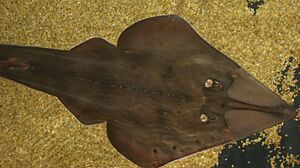Blackchin guitarfish facts for kids
Quick facts for kids Blackchin guitarfish |
|
|---|---|
 |
|
| Conservation status | |
| Scientific classification | |
| Genus: |
Glaucostegus
|
| Species: |
cemiculus
|
| Synonyms | |
|
|
The blackchin guitarfish (Glaucostegus cemiculus) is a special type of fish with a skeleton made of cartilage, not bone. It lives on the ocean floor in the eastern Atlantic Ocean and the Mediterranean Sea. This fish likes to eat crustaceans, other small ocean creatures, and even smaller fish. Female blackchin guitarfish give birth to live young, just like mammals. Sadly, this fish is in danger because of fishing. Its numbers are going down, and its fins are highly valued. Because of this, the International Union for Conservation of Nature says it is "critically endangered". This means it faces a very high risk of becoming extinct in the wild.
Contents
What Does the Blackchin Guitarfish Look Like?
The blackchin guitarfish has a plain brown back and a white belly. It has a dark spot on its snout, which is easier to see when the fish is young. It looks a lot like the common guitarfish, which lives in the same areas.
You can tell the blackchin guitarfish apart by a few things:
- It has smaller eyes.
- Its snout ridges are narrower and almost join at the front.
- Its front nasal lobe is shorter.
- Its back nasal flap is narrower.
Both types of guitarfish have small thorns. These thorns are found near their eyes, on their shoulders, and along their spine and tail. However, these thorns are not as clear on the blackchin guitarfish. This fish can grow to be about 180 centimetres (71 inches) long. Some even larger ones have been seen near Guinea and in the Gulf of Gabès.
Where Does the Blackchin Guitarfish Live?
The blackchin guitarfish lives in the eastern part of the Atlantic Ocean. You can find it from the northern coast of Portugal all the way down to Angola. It also lives in the southern and eastern parts of the Mediterranean Sea. Recently, it has even been seen in the Black Sea. This fish prefers to live on the continental shelf, which is the shallow edge of the continent under the sea. It usually stays in waters up to about 100 metres (328 foots) deep.
What Does It Eat and How Does It Grow?
The blackchin guitarfish swims slowly over sandy and muddy parts of the seabed. It searches for food like shrimps, crabs, other crustaceans, squid, and shellfish.
Males become ready to have babies when they are about 150 cm (59 in) long in Senegal. Females are ready when they are about 163 cm (64 in) long there. In Tunisia, they become mature at smaller sizes: males at 100 cm (39 in) and females at 110 cm (43 in).
This fish is ovoviviparous. This means the eggs stay inside the mother's body. The young fish grow inside her, first getting food from a yolk sac. Later, they get food from special fluids made by the mother. A mother usually has between four and six babies in Senegal. In Tunisia, she might have more. The babies grow inside the mother for about five to eight months. Sometimes, in colder water, the baby's growth might pause for a while. This pause is called a diapause. It seems this pause does not happen in Tunisia.
Why Is the Blackchin Guitarfish Endangered?
The blackchin guitarfish does not have many babies. Adult fish gather near the coast at certain times of the year to give birth and mate. During these times, they are very easy for fishermen to catch. This species is highly valued for its fins, which are sold for a high price. The fish are also caught for food.
They are caught using large nets called trawls and also with gillnets by small-scale fishermen. They are also caught by accident during industrial shrimp fishing. The blackchin guitarfish and the common guitarfish used to be very common in the northern Mediterranean. They were also found around the Balearic Islands. But now, they seem to be gone from these areas. Catches off the coast of Africa have also gone down. However, it is hard to get exact numbers on how many are being caught. The International Union for Conservation of Nature is very worried about the future of this fish. They have said its conservation status is "critically endangered".


